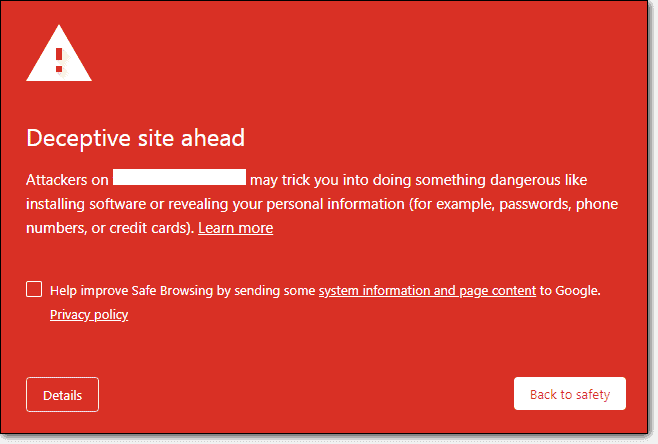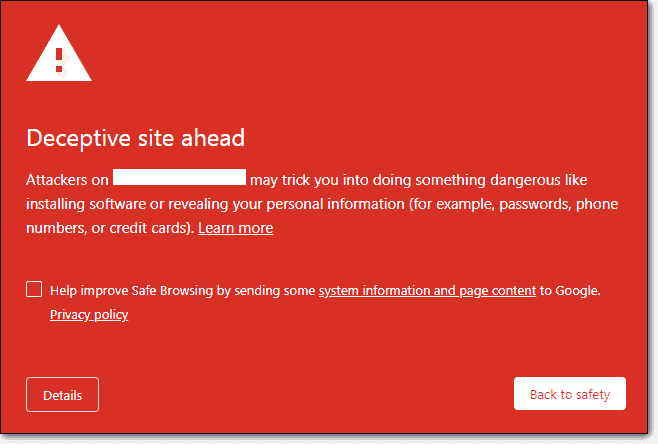
How does it feel when your customer comes up to you with a security warning on their website? As a WordPress website owner, it can be a disheartening and alarming experience. The deceptive site ahead warning issued by the Google search engine serves as a reminder of the importance of website security. In this blog post, we will delve into the implications of the deceptive site warning and provide you with valuable insights to secure your WordPress website, ensuring a trusted online presence and peace of mind for both you and your customers.
1. Understanding the Deceptive Site Ahead Warning
Have you ever encountered the "Deceptive Site Ahead" warning while searching for a website? Imagine that same warning being associated with your WordPress website. It can have a significant impact on your reputation and customer trust. Understanding the warning and its consequences is the first step towards safeguarding your online presence. If you have a firewall installed for the website, read the most recent scan report and analyse if there is some vulnerability reported. Try to fix it first-hand. It might be some malicious file in the file structure of your WordPress folder or a corrupted image file or an issue due to mixed content (which occurs when permalinks are not set properly).
2. Regular Updates and Security Patches
Outdated WordPress core, themes, and plugins can leave your website vulnerable to attacks. By prioritizing timely updates, you can close potential security loopholes and protect your customers' valuable data.
3. Implement SSL/TLS Certificates
The security of your customers' information is paramount. Seeing that warning on their website can make you realize the necessity of implementing SSL/TLS certificates. By encrypting the communication between your website and visitors' browsers, you can establish a secure connection and instil confidence in your customers that their sensitive information is being transmitted safely. Check if the SSL certificate is outdated or if SSL is not configured properly for the site. Fine-tune it.
4. Choose Reliable Themes and Plugins
When selecting themes and plugins for your WordPress website, make sure to choose reputable sources. Opt for themes and plugins that are actively maintained, regularly updated, and have positive user reviews. Avoid downloading free themes and plugins from untrusted third-party websites, as they may contain malicious code.
5. Strong Passwords and User Authentication
A strong password policy is vital to protect your WordPress website. Encourage users to create unique, complex passwords that include a combination of uppercase and lowercase letters, numbers, and special characters.
6. Limit Login Attempts and Use Secure Login URLs
Limiting the number of login attempts can deter brute-force attacks. Consider using a plugin that restricts the number of login attempts from a specific IP address within a defined timeframe.
Additionally, change the default login URL (/wp-admin) to a custom one to reduce the chances of automated attacks targeting the login page.
7. Implement a Web Application Firewall (WAF)
A web application firewall acts as a protective barrier between your website and potential threats. It filters out malicious traffic, blocks suspicious requests, and helps prevent common attacks such as SQL injections and cross-site scripting (XSS). Choose a reputable WAF plugin or consider utilizing a cloud-based WAF service for enhanced security.
8. Regular Backups and Disaster Recovery Plan
In the event of a security breach or website compromise, having a recent backup is crucial. Regularly back up your WordPress website, including the database and files, and store the backups in a secure location. Additionally, create a disaster recovery plan to outline the steps to follow in case of a security incident, ensuring a swift response and recovery process.
8. Secure Hosting Environment
Choose a reputable hosting provider that prioritizes website security. Look for providers that offer features such as SSL certificates, regular server updates, malware scanning, and firewall protection. Additionally, consider a hosting plan that provides isolated accounts, so a compromised website doesn't impact others on the same serve
Securing your WordPress website is an ongoing process that requires a proactive approach. By implementing the best practices outlined in this guide, you can significantly reduce the risk of security breaches, protect sensitive data, and provide a safe browsing experience for your users.
Stay vigilant, keep up with the latest security trends, and make website security a top priority to safeguard your WordPress website in today's ever-evolving threat landscape. For tips and tricks on securing your WordPress website, sign up for Unilakes and receive advanced support in the matter.
Get in contact with unilakes.com or call us at +61 (4) 8264 7200.
By:
Rabeea Hammad
Customer Success Manager
Unilakes Technologies


Recent Comments